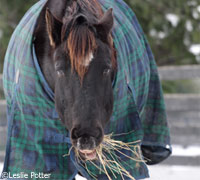 |
| Horses need additional high quality forage in the winter. Photo: Leslie Potter |
An cold snap has fallen on much of the eastern United States, and owners of horses
and livestock are encouraged to take precautions. Cold temperatures combined with gusty wind can
create dangerous conditions for animals living outdoors.
maintain core body temperature. Horses may need additional food, especially if they are kept
outside, said Laurie Lawrence, University of Kentucky College of Agriculture equine researcher and
professor.
“Because a large change in the grain portion of the diet can increase the risk of digestive upset,
horse owners should also focus first on increasing the amount and/or quality of the hay that is
used,” she said. “In general, horses will obtain more calories from alfalfa or alfalfa-grass mix
hay than from plain grass hay. If horses have already reached maximum hay consumption, then an
increase in grain can be implemented. However, all changes to grain intake should be made
gradually.”
According to Lawrence, regular body condition scoring is also recommended for horses. Heavy hair
coats can often camouflage weight loss in horses, so it is important that horse owners check the
amount of fat cover over the ribs and spine regularly, she said. If the boney structures start to
feel more prominent, it is an indication the horse is losing weight and that the diet should be
changed.
Lawrence offered another tip. “Sorting horses by age, body condition and nutrient requirements
makes it easier to feed each group of horses appropriately. Horses are less efficient at digesting
low quality hay than cattle, so it is very important to offer them good quality hay in adequate
amounts. Under normal conditions adult horses will usually consume 20 to 25 pounds of good quality
hay per 1,000 pounds of body weight each day. During cold weather this allocation should be
increased by 30-50 percent, depending on the severity of the weather.
“The importance of making sure animals have adequate water cannot be understated,” she added.
“When water availability decreases, food intake usually decreases as well. So if even if horses
have plenty of food available they may not eat enough if their water source is frozen.”
According to Jeff Lehmkuhler, University of Kentucky College of Agriculture beef specialist, the
lower critical temperature (LCT) value for cattle is the lowest temperature or windchill at which
no additional energy is required to maintain core body temperature.
This same principle applies to horses.
“As the temperature declines below this lower critical value, the maintenance energy value for the
animal is increased to maintain core body temperature,” Lehmkuhler said. “Animals maintain core
body temperature by increasing their metabolism resulting in greater heat production, as well as
other heat conservation strategies such as reducing blood flow to the extremities, shivering and
increasing intake.”
Lehmkuhler explained the hair coat acts as insulation similar to home attic insulation that traps
air, enhancing the insulating value. If the hair is wet and full of mud, air is excluded, reducing
the insulating value and increasing heat loss from the skin to the environment. The density of the
hair coat and its moisture level impacts the windchill temperatures at which cold stress is
considered mild, moderate or severe. As little as 0.1 inch of rain can immediately impact cold
stress severity by matting the hair down reducing its insulating ability. Acclimation time, hide
thickness, fat cover and other factors will also influence the degree of cold stress animals
experience.
Similar to cattle, a horse with a thick coat has more insulation, and will lose less heat, than a
horse with a thin coat, Lawrence said.
“Another factor that can influence LCT is the size of the animal. Smaller animals have a greater
surface area relative to body weight and thus a larger area that can lose heat. Therefore weanling
horses may reach their LCT before a mature horse. Horse owners should be aware that cold weather
can slow growth because calories are diverted from weight gain to temperature maintenance. To
minimize a growth slump during very cold weather, young horses should be given more calories by
increasing hay quality and quantity and by providing adequate grain supplementation,” Lawrence
said.
Further Reading
30 Ways to Weather Winter
Snow Days







Thanks for the information. Cute picture.
HAY< hay, hay, hay Hay is for horses! I liked this article.
My horse eats twice as much hay in the winter. Funny photo.
Good point about smaller horses having more surface to lose heat from!
What about blankets?
Ditto Donald: I’d like to see a study that shows how blanketing impacts equine calorie needs/intake. The UK college of Ag. would be an ideal candidate to tackle that project!
All the information is great and very useful. I would like to know how much would be the minimum that would be suggested for horses 6-12, 1,000 lbs. Due to the economy funds aren’t going far these days and with 9 (some rescue)horses to feed I’m looking to make sure all are healthy and happy in my care.